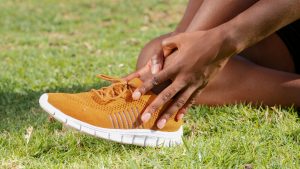
What is Tibialis Posterior Tendinopathy?
To start broadly, tendinopathy is a progressive condition whereby a tendon (the connection between our bones and muscles) is not functioning correctly. The tibialis posterior tendon runs down the inside of the leg behind the ankle bone and connects onto the middle of the foot. It helps to support the arch of the foot and ankle (Lhoste-Trouilloud, 2012). Tibialis posterior tendinopathy (TPT) is a condition that causes pain and/or dysfunction of this tendon in activities such as walking, running, and jumping, and may be noticed more when going up hills.
What causes Tibialis Posterior Tendinopathy?
Tendons are designed to adjust and withstand the load that we put through our muscles and bones depending on the activity. If a load is placed on the tendon that exceeds the tendons capacity, or ability to recover, tendinopathy will occur: pain and dysfunction of the tendon. TPT may result from an excessive loading through a tensile force in the tendon when supporting the foot arch, for example, suddenly increasing your running load. TPT may also occur if we suddenly change our footwear or have excessively flat feet, causing a friction / compressive force, where the tendon gets irritated as it wraps around our foot bone.
Conditions that may be related to Tibialis Posterior Tendinopathy
Other conditions that may relate to TPT, or be confused as this condition include arthritis, neuromuscular diseases, and damage to ligaments of the foot (Knapp, 2019).
Common symptoms / signs
Commonly, people will report a slow onset of foot pain on one foot, often after a sudden increase of physical activity, such as training for a marathon when previously not a runner. Other common signs include a history of foot trauma, anatomically flatter feet, pain and swelling along the foot and ankle, pain when walking up and down stairs or impaired balance amongst other signs.
How is Tibialis Posterior Tendinopathy treated?
As Physios, we like to think of our tendons as a doughnut; the hole part is the dysfunctional or painful part of the tendon. However, we have lots of well-functioning, pain-free tendons (donut!) around the hole. This means that we should (and it is important to!) rehab these conditions through exercises, and the research now tells us that tendons don’t heal well with complete rest; tendons like to be loaded (Cook et al., 2010). Specifically, we begin treating tendinopathies with isometric exercises, these are static positions. Exercises might include some specific foot or toe holding positions. These exercises will progress as pain subsides to start building strength.
A few other things we may have a look at including your current load and how we can modify this to reduce the loading on this tendon, and potentially adjust your footwear (Blasimann, 2015).
Risk factors for Tibialis Posterior Tendinopathy
Risk factors for tendinopathies can be broken into two major categories:
|
Intrinsic |
Extrinsic |
|
Older age and or menopause in women Genetics Excess adiposity Systemic conditions (inflammatory and autoimmune conditions) Hyperlipidaemia Pes planus (flat feet) Previous trauma (certain ankle fractures |
Load – a history of changing loads (possibly the greatest factor!)
(Cardoso et al., 2019) |
References:
Blasimann A, Eichelberger P, Brülhart Y, El-Masri I, Flückiger G, Frauchiger L, Huber M, Weber M, Krause FG, Baur H. Non-surgical treatment of pain associated with posterior tibial tendon dysfunction: study protocol for a randomised clinical trial. Journal of foot and ankle research. 2015 Aug 14;8(1):37.
Bowring, B., & Chockalingam, N. (2010). Conservative treatment of tibialis posterior tendon dysfunction—A review. The Foot, 20(1), 18-26.
Cook, J. L., Rio, E., Purdam, C. R., & Docking, S. I. (2016). Revisiting the continuum model of tendon pathology: what is its merit in clinical practice and research? Br J Sports Med, 50(19), 1187-1191. doi:10.1136/bjsports-2015-095422
Cardoso, T. B., Pizzari, T., Kinsella, R., Hope, D., & Cook, J. L. (2019). Current trends in tendinopathy management. Best Pract Res Clin Rheumatol, 33(1), 122-140. doi:10.1016/j.berh.2019.02.001
Knapp PW, Constant D. Posterior Tibial Tendon Dysfunction. May 2019 Available
Kong, A. Van der Vliet. Imaging of tibialis posterior dysfunction. The British Journal of Radiology, 2008 Oct;81 (970): 826–836
Lhoste-Trouilloud, A. (2012). The tibialis posterior tendon. Journal of ultrasound, 15(1), 2-6.
